Welcome!
Welcome to Structural Design & Scantling with ISO 12215!
Structural design and scantling determination are crucial steps in a vessel’s design process since providing sufficient structural strength is one of the main objectives when designing floating devices. Moreover, they also affect other aspects of a vessel, such as resistance and stability.
Scantling is the process of defining and calculating the structural elements of a vessel. While the design of the structure is a matter of the designer’s experience, the scantling must follow standards issued by national or international bodies or by classification societies depending on the homologation target the designer is looking for.
The “ISO 12215 – Small craft. Hull construction and scantlings” is an international standard focusing on the scantling determination of recreational and commercial craft and workboats up to 24 meters long. Compliance with ISO 12215 is mandatory for obtaining the CE marking and, therefore, for selling boats in the European Union.
The ISO 12215 standard has been prepared by the Technical Committee ISO/TC 188 “Small craft,” which focuses on the standardization of equipment and construction details of recreational craft, and other small craft using similar equipment, up to 24 meters length of the hull.
What will you learn?
In this course, we equip the students with the knowledge and tools required to understand and perform Structural Design & Scantling with ISO 12215. Besides, the course provides numerous examples and downloadable calculation templates where the students can see how the calculations are done (very useful for understanding & learning), analyze the results, and use them on their projects.
The course is divided into three parts:
- The first part presents a theoretical study of the strength of materials and theoretical considerations regarding the structural design and scantling process.
- The second part explains the ISO 12215 Standard, including its structure, the rules established to compute design pressures, and the formulae for scantling determinations. Some aspects will be treated separately, such as the rudder, the keel, and the rigging.
- Within the third part, the knowledge acquired in parts 1 and 2 is applied to perform practical examples over a 17m length GPR sailboat, such as the calculation of:
- Composite properties.
- Monolithic panels.
- Sandwich panels.
- Stiffeners.
- The rudder with ISO 12215-8.
- The keel with ISO 12215-9.
- The rig with ISO 12215-10.
After completing the course, you will be able to design the structure and evaluate the scantling of yachts and boats by applying the ISO-12215 standard. Speaking more precisely, you will be able to:
- Understand the fundamentals of the science of strength of materials behind the formulae and procedures described in the ISO 12115 standard.
- Understand the fundamentals of the structure definition process, including the different types of structural elements to be considered, the types of structures, and notions about the building process.
- Design the structure of yachts and boats.
- Use the ISO 12215 standard to compute the properties of composite materials.
- Determine the design pressures to be considered in the scantling process according to the ISO 12215 standard.
- Determine the scantling of panels (thickness) and stiffeners (sections) in the different areas of the hull according to the ISO 12215-5 standard.
- Determine the scantling of the keel and the rudder of sailing yachts according to the ISO 12215-8 and ISO 12215-9 standard.
- Calculate the structure of the rigging of sailing yachts according to the ISO 12215-10 standard.
Course organization
The course is video-based and on-demand and can be followed at your own pace.
It contains videos, quizzes, and downloadable documents and gives access to the course’s classroom, a virtual place to interact with the instructors and fellow students.
Students completing the course will obtain the Course Certificate.
– Resources:
- Video lessons.
- Written documentation (pdf files).
- Calculation templates (spreadsheets).
- Quizzes.
- Course Certificate.
– Classroom:
– Prerequisites:
- To follow the course, it is not necessary to have any prior knowledge of scantling. However, a technical or engineering background will help you during the journey. Also, a basic background in physics and mathematical concepts is assumed.
- A minimum Navalapp membership level of “Subscriber” (free membership) is required to enroll in this course.
RINA Endorsement

After a thorough evaluation, the Royal Institution of Naval Architects (RINA) has found that Navalapp’s course Structural Design & Scantling with ISO 12215 meets the requirements for Continuing Professional Development (CPD) of the Institution. Therefore, RINA has considered that the course warrants their recognition and has issued a Certificate of Endorsement.
During the evaluation, RINA studied different aspects of the course, such as learning aims, content and structure, whether the information is up-to-date and is factually correct, students’ evaluations of the course, the supporting information and materials, the instructor’s expertise, the method by which the students are evaluated, and Navalapp’s organization standards.





